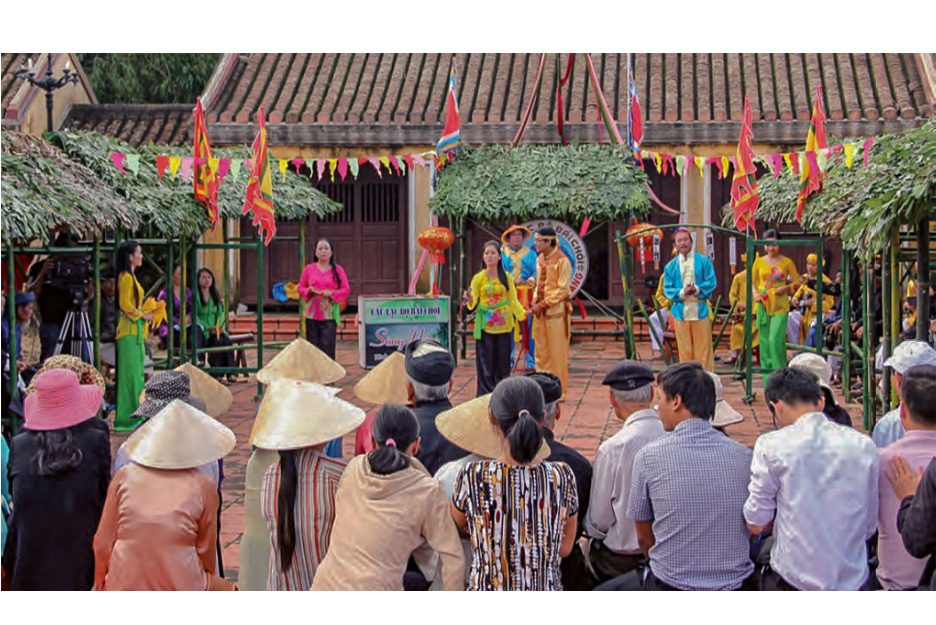Nguyen Binh Dinh
Director, Vietnamese Institute for Musicology
The Vietnamese Institute for Musicology and the Binh Dinh Department of Culture, Sports and Tourism have jointly organized Bai choi Folk Art of Vietnam and Similar Art Forms around the World, an international conference held on 13 and 14 January 2015 in Qui Nhon City, Binh Dinh Province, Vietnam.
The conference was held to promote the special values of bai choi heritage to international music researchers and heritage scholars. At the same time, the conference allowed the international community to share information about similar arts around the world. It was a valuable opportunity in a number of ways. On the one hand, the participants had a chance to connect with relevant organizations, communities, and individuals and share heritage information. On the other hand, it served as an important activity within the roadmap to build the nomination file, Bai Choi Folk Art of Central Vietnam.
Conference participants included Ms. Dang Thi Bich Lien, Deputy Minister of the Ministry of Culture, Sports and Tourism as well as representatives from the Agency for Cultural Heritage, the Agency for International Cooperation, the Vietnam National Commission for UNESCO, the Vietnam National Academy of Music, the Vietnam Cultural Heritage Council, the Vietnam Folk Art Association, and the Departments of Culture, Sports and Tourism of nine provinces and cities where bai choi is practiced. Also in attendance were Vietnamese culture and music researchers and scholars from France, German, Laos, Sweden, and Korea.
Traditional Music of Bai Choi
Bai choi, originating in the fifteenth or sixteenth century as a ritual for better harvests and bringing communities together, is unique to the central coastal region of Vietnam and performed locally during spring festivals. Resembling a game, bai choi is similar to bingo, but it also includes music, song, and poetry.
The performances take place outdoors, where nine open huts are built for the event. One hut, the central hut, is reserved for a troupe of musicians, and the other eight huts house five or six players each. Prior to play, a deck of cards is cut, and one half is distributed among the players, and the other is placed in a box at the central hut. On each card are three symbols related to Vietnamese culture, and these can include numbers written in Han Nom.
Accompanied by the troupe, the hieu (game singer) gives a flag to each hut while singing about daily life and work. The songs are emotional and tend to praise parental and conjugal affection and national pride while also criticizing behavior that goes against society. On returning to the central hut, the hiệu draws a card from the box and sings the symbols that are on the card. Whoever has a card that best matches the game singer’s card gets a yellow flag, At the end of the evening, the person who has the most yellow flags wins a prize, usually something small and of little or no material value.
Folk Artists at the Conference
By introducing and explaining bai choi, the bai choi folk artists—Mr. Nguyen Kiem (Binh Dinh Province), Mr. Nguyen Minh Dung (Binh Dinh Province), Ms. Le Thi Dao (Binh Dinh Province), Mr. Nguyen Minh Chau (Quang Ngai Province), and Mr. Tu Hai (Khanh Hoa Province)—clarified issues related to how to build huts, use cards in the performance, sing and read the name of the cards, play musical instruments, and perform solo drama excerpts. The breadth of the explanations and the addition of useful illustrations helped the participants gain a better understanding and feel for the features, values, and vitality of bai choi. The event was made more memorable thanks to the bai choi performance by Nguyen Kiem, a folk artist from Binh Dinh Province.
Researchers and Scholars
Vietnamese researchers surveyed and analyzed issues related to the historical characteristics, cultural values, literary values, and musical features of bai choi. In their presentations they summarized their findings, emphasizing the performance art of the male and female singers, ways of playing the bai choi card game, and the local differences in the ways of performing bai choi. While the information they presented was important, the parts that drew the most attention were related to the current status of bai choi as well as the actions that have been done (or will soon be done) to preserve and promote this valuable heritage of Vietnam.
Presentations by international scholars—Prof. Dr. Yves Defrance (France), Prof. Dr. Gisa Jaehnichen (Germany), Prof. Dr. Tran Quang Hai (France), Ebsjorn Watermark (Sweden), Dr. Buontheng Souksavads (Laos), and Dr. Seong-Yong Park (Korea)—were valuable in providing points of reference, comments, and reviews of bai choi. Moreover, they provided analysis and a comparative framework by showing similarities of bai choi in other art forms found around the world. In doing so, they clarified the values and specific features that make this kind of intangible heritage and important part of a greater global community.
Conclusion
The success of the two-day conference can be measured in the participants’ greater understanding of bai choi as a valuable intangible cultural heritage element of humanity. Through the meeting, many aspects of bai choi were clarified and elaborated upon. In light of the developments made at the conference, the delegates believe that bai choi deserves to be inscribed on the UNESCO Representative List of the Intangible Cultural Heritage of Humanity.







